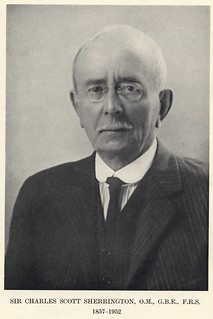In his early career, Sherrington was interested in bacteriology, haematology and the cerebral cortex. However, after being exposed to the work of Walter Holbrook Gaskell, he moved his research interest into the field of the spinal cord. This interest of his can be seen in his histological slide box, which is full of sections from the spinal cord.
In 1887 Sherrington was selected to be a Fellow of Caius College, University of Cambridge, and a lecturer in physiology at St Thomas’ Hospital, London. In his Physiological Laboratory, Sherrington continued his research on the spinal cord of the dog and carried out two post-mortem examinations on the spinal cord from patients of St Thomas’ Hospital. The first post-mortem examination was from a 63 year old man who died of a haemorrhage in the “motor part of the left internal capsule”. Sherrington and Hadden concluded that the spinal axon degeneration corresponded to Sherrington's findings in the lesions of dog in the same area. In the second examination, carried out on a 35 year old man who died following back pain and inability to walk, they were able to trace the anterolateral spinal tract to the cerebellum. Using these cases, Sherrington compared the degeneration of spinal nerves in humans with the degeneration in the dog brain. His great interest into the spinal cord is shown by several slides in the histological box featuring human cases of syringomyelia and tabes dorsalis and preparations of the spinal cord and medulla from monkeys, cats and humans.
Sherrington’s slide box contains several slides featuring labels pointing at cells located at the edge of the spinal cord. He called these neurons variously 'outlying nerve cells' and 'spinal border cells'. His interest into these cells was great, as he believed they caused the sustained tonic inhibition of extensor muscle α-motor neurons in the cervical enlargement. However, later on these cells were identified as spinocerebellar tract neurons, which relay information about limb position and movement to the cerebellum. Gaskell was the first person to describe border cells, which he identified as neurons scattered at the periphery of the lateral column in the spinal cord of the alligator.
One of Sherrington’s greatest achievements was his research on spinal reflexes, with which he laid the foundations of our current understanding of spinal cord circuits. He described in great detail the distribution of efferent fibres in spinal nerves of the lumbosacral plexus of frogs, rats, rabbits, cats, dogs and rhesus monkeys. His method involved stimulating the ventral efferent spinal roots of rhesus monkeys and cats using platinum electrodes and then examining the resulting movements. By doing this for every branch of the efferent spinal nerves, he showed that, for each each limb, muscle contraction could be induced by two or three different spinal roots. Furthermore, he identified the cutaneous sensory fields of the afferent spinal nerves and thus was able to describe the part of the skin that activates each sensory spinal nerve branch. The term he used to describe this was the ‘sensory spinal skin-field’. Thus, he identified both the sensory and the motor parts of the spinal reflex. Using the ‘successive degeneration method’, Sherrington was able to study the scratching, shaking and other reflexes in dogs. He detected afferent arcs from the sensory receptors in the skin to the spinal cord and then followed the efferent pathways from the motor neurons to the flexor muscles. His interest in the spinal cord and the reflexes can be seen by the preparations of dorsal root ganglion cells and sympathetic paravertebral ganglion cells, which are found in his box of slides.
Sherrington’s interest in the spinal cord was evidently great, as most of his later research was devoted to this part of the body, which can be seen by the sheer number of slides in his box dedicated to the spinal cord.
Zoltán Molnár, Richard E. Brown, Insights into the life and work of Sir Charles Sherrington, Nature Reviews Neuroscience 11, 429-436 (June 2010)
- No links match your filters. Clear Filters


















